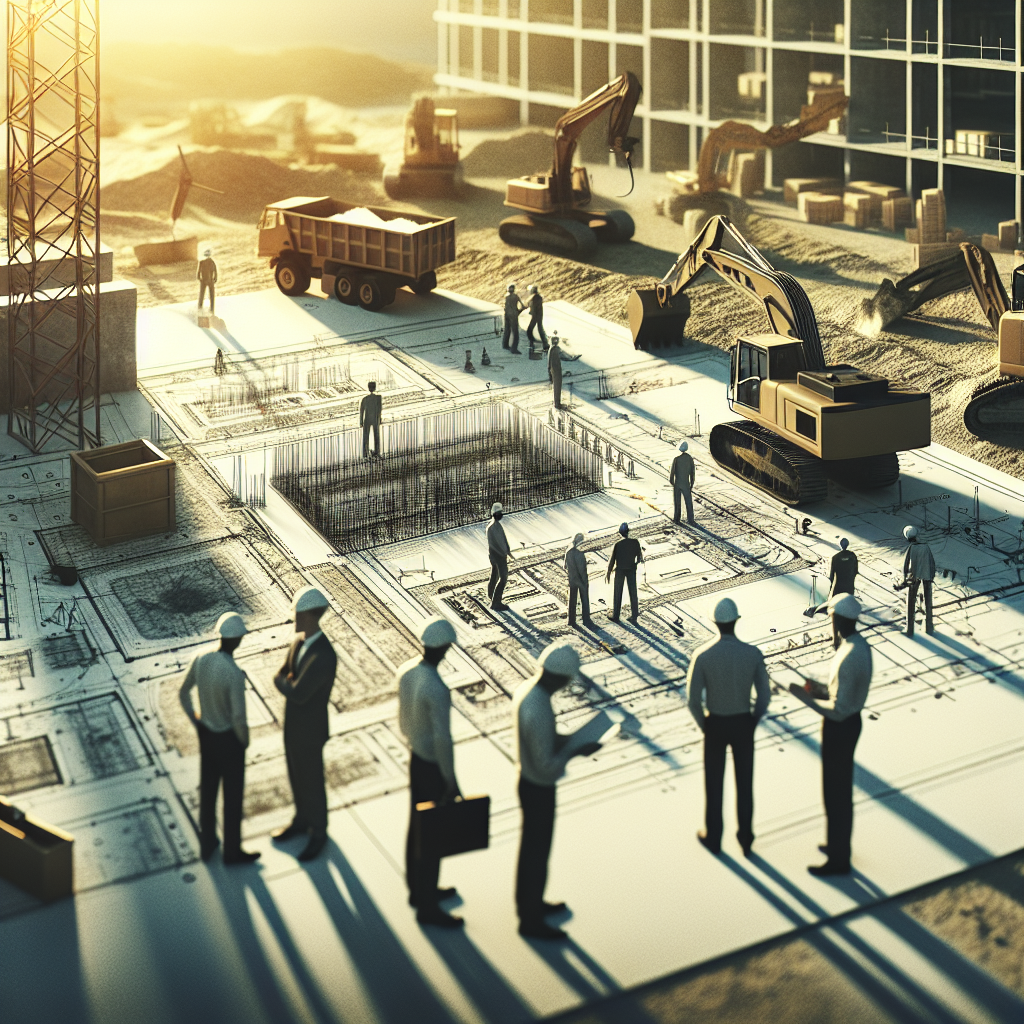Introduction to Site Development and Planning in Construction
Ever wondered what ties all the different components of a construction site together?
Understanding the intricacies of a built environment requires us to dig a little deeper into something known as a Site Development Plan (SDP). The SDP functions as a roadmap guiding the process of construction from conception to completion.
In this article, we aim to clarify the SDP, explore essential components, examine its importance, and look at the ins and outs of site development and planning.
Think of the SDP as a blueprint detailing key aspects ranging from property boundaries to utilities layout.
Did you know that the SDP serves as a vital tool for communication among stakeholders?
Or that it is of paramount importance in ensuring project feasibility, efficient space utilization, and risk management?
We will then shift gears and cover the site development process, examining its initiation, subsequent stages, and the concept of revisiting the SDP. Following this, we outline the steps involved in site planning and distinguish it from site development. Finally, we look closely at the increasing role of technology in site planning.
Let’s get started!
Table of Contents
Understanding Site Development Plan in Construction
Definition of a Site Development Plan
A site development plan is a detailed engineering and design document that illustrates the layout of a construction project. It focuses on the arrangement of structures, landscaping, and amenities on a physical site. This plan is essential for communicating how space will be used and developed effectively.
Key Components of a Site Development Plan
A well-prepared site development plan typically includes the following elements:
- Property Boundaries: Defines the legal limits of the property on which construction will take place.
- Building Locations: Shows where structures will be situated within the site.
- Access Points: Details entry and exit points for vehicles and pedestrians.
- Parking Areas: Illustrates the layout and capacity of parking accommodations.
- Landscaping: Includes plans for plants, trees, and other greenery.
- Utilities: Layout of water, sewer, electrical, and gas lines.
- Topography: Details about the elevation and contour of the site.
Importance of a Site Development Plan
Understanding why a site development plan is important involves recognizing its value in several areas:
| Aspect | Importance |
|---|---|
| Project Feasibility | Assesses if the planned development aligns with zoning laws and regulations. |
| Efficient Use of Space | Maximizes space utilization while ensuring accessibility and functionality. |
| Risk Management | Identifies potential issues such as flooding or drainage problems early in the process. |
| Stakeholder Communication | Serves as a clear visual tool for communicating plans to all parties involved. |
Regulatory Compliance
Site development plans often need to be submitted to local authorities to ensure they comply with zoning and building codes. This process is vital for obtaining the necessary permits before breaking ground.
For more information on site development plans, you can refer to ArchDaily, a well-regarded resource in the architecture and construction industry.
The Site Development Process Explained
Initiating the Site Development Process
Site development begins with thorough research and understanding of local zoning regulations, environmental restrictions, and other potential land uses. This step involves a comprehensive site analysis that accounts for potential challenges and hurdles related to the site’s geographical, environmental, and civic characteristics. Following this, hiring a qualified team of architects and civil engineers is essential as it ensures the crafting of an efficient and effective site development plan.
Stages of Site Development
The site development process is multi-staged and continuous:
- Planning Phase: Collects and documents the necessary details about the site. Applies to the development of the project’s initial design.
- Design Phase: Architects draft a precise representation of the structure with detailed specifications of its features.
- Permitting Phase: Once the design is finalized, drawings are submitted to local authorities to obtain necessary building and development permits.
- Construction Phase: Actual construction starts aligning with the site development plan. Regular monitoring and supervision ensure the plan is followed meticulously.
- Inspection Phase: Following the construction phase, several inspections are conducted to ensure compliance with building codes and regulations.
Revisiting Site Development Plan
Despite careful planning and monitoring, there can be unexpected issues and obstacles that prompt the revision of the original site development plan. To deal with such changes effectively, a well-structured site development process includes mechanisms to revisit the plan and make adjustments necessary for the successful completion of the project.
Project Completion and Evaluation
After the construction is complete and the project is brought to life, a comprehensive evaluation of the site development plan is conducted. This evaluation considers the efficiency of the implemented plan, the effectiveness in handling unexpected changes, issues encountered during construction, and the overall success of the project. These insights are invaluable for refining future site development plans.
For more in-depth information about site planning, you can explore American Planning Association, a renowned organization specializing in urban and regional planning.
Exploring the Concept of Site Planning
Definition of Site Planning
Site planning involves the strategic design and arrangement of land use, infrastructure, and structures within a specific site. The goal is to optimize the functional, aesthetic, and environmental aspects of a space. This process considers topography, climate, ecology, and social factors to create a cohesive and practical development blueprint.
Steps in Site Planning
The site planning process generally follows these key steps:
- Site Assessment: Involves analyzing the physical, ecological, and cultural attributes of the site, which helps determine suitable uses.
- Goal Setting: Defines the objectives and vision for the site, often involving stakeholder input to ensure goals align with community needs.
- Concept Development: Drafts potential layouts and configurations, incorporating land use, access routes, and service placements.
- Design Development: Refines chosen concept with detailed planning for infrastructure, utilities, and landscape design.
- Implementation and Monitoring: Oversees the construction and ongoing management, ensuring the project follows the site plan.
Site Planning vs. Site Development
While often used interchangeably, site planning and site development have distinct roles in construction:
| Aspect | Site Planning | Site Development |
|---|---|---|
| Focus | Conceptualizing land use and layout | Executing construction according to plan |
| Stage | Early-stage evaluation and design | Later-stage physical development |
| Scope | Broad, strategic vision | Detailed, tactical execution |
| Outcome | A comprehensive layout plan | A completed project |
Technological Tools in Site Planning
Modern site planning benefits greatly from technological advancements:
- GIS (Geographic Information Systems): Provides spatial data and analysis for informed decision-making.
- BIM (Building Information Modeling): Integrates digital representations for enhanced design collaboration and accuracy.
- CAD (Computer-Aided Design): Offers precision in drawing and visualizing potential layouts and structures.
For further exploration into the nuances of site planning in construction, the American Society of Landscape Architects is an excellent resource offering insights and case studies in landscape architecture and site planning practices.
Essentials of Effective Site Planning in Construction
Role of Site Analysis in Site Planning
Site analysis is foundational in site planning, providing a critical understanding of the land’s existing conditions and constraints before design even begins. This involves evaluating aspects such as:
- Soil Quality: Determines suitability for construction and landscaping.
- Climate Patterns: Influences design decisions related to orientation, shading, and energy use.
- Biological Factors: Considers the presence of native species and ecosystems that need protection.
- Cultural Significance: Acknowledges historical or social elements of the site that might influence design.
Integration of Sustainability in Site Planning
Modern site planning prioritizes sustainability by incorporating:
- Renewable Energy: Designing orientation and structure to maximize solar and wind energy usage.
- Water Management: Plans for rainwater harvesting and reduction of runoff to enhance water conservation.
- Green Infrastructure: Use of green roofs, permeable paving, and urban vegetation to improve air quality and reduce heat.
Community Engagement in Site Planning
Engaging community stakeholders is essential in the site planning process to ensure the development aligns with local needs and expectations. Public consultations, community workshops, and feedback sessions help gather valuable insights that guide the planning process.
Regulatory Frameworks and Site Planning
Site planners must understand and work within a web of regulations, including:
- Zoning Laws: Dictate the type of developments allowed on a property.
- Environmental Legislation: Protects natural resources and enforces environmental protection standards.
- Building Codes: Ensure safety and structural integrity standards within the built environment.
Utilizing Digital Tools for Enhanced Site Planning
Advanced digital tools streamline and enhance the site planning process:
- 3D Modeling Software: Creates virtual models to visualize the impact and outcomes of design choices.
- Virtual Reality (VR): Immerses stakeholders in a simulated environment for insightful feedback during planning stages.
- Augmented Reality (AR): Provides on-site visualization to detect potential design conflicts early.
Conclusion: Navigating Site Planning in Construction
In essence, understanding and executing a site development plan and site planning are key ingredients for successful construction projects.
These processes utilize engineering & design expertise, strategic arrangement of structures, landscaping, and amenities, ensuring efficient use of space, risk management, stakeholder communication, and regulatory compliance. These concepts contribute to the building’s overall functionality, aesthetic appeal, and environmental sustainability.
The practices of site planning and site development are distinct yet interconnected phases of construction, from conceptualization to the final project output. They are boosted by modern technological tools like Geographic Information Systems, Building Information Modeling, and Computer-Aided Design, streamlining the processes and enhancing accuracy and efficiency.
To ensure sustainability and community satisfaction, these processes also integrate renewable energy, water management strategies, green infrastructure, and community engagement practices.
Frequently Asked Questions – FAQs
What is the difference between site planning and site development?
In the context of construction, site planning revolves around conceptualizing land use and layout. On the other hand, site development focuses on executing the construction according to the established plan.
What are the key components of a site development plan?
A comprehensive site development plan includes elements like property boundaries, building locations, access points, parking areas, landscaping, utilities, and topography.
How are modern technological tools used in site planning and development?
Technologies like GIS, BIM, CAD, 3D modeling software, Virtual Reality, and Augmented Reality provide enhanced design collaboration, precision in drawing, visualizing potential layouts, and early detection of design conflicts.
Why is community engagement crucial in site planning?
Community engagement ensures that the development aligns with local needs and expectations. Through public consultations, community workshops, and feedback sessions, valuable insights are gathered to guide the planning process.






